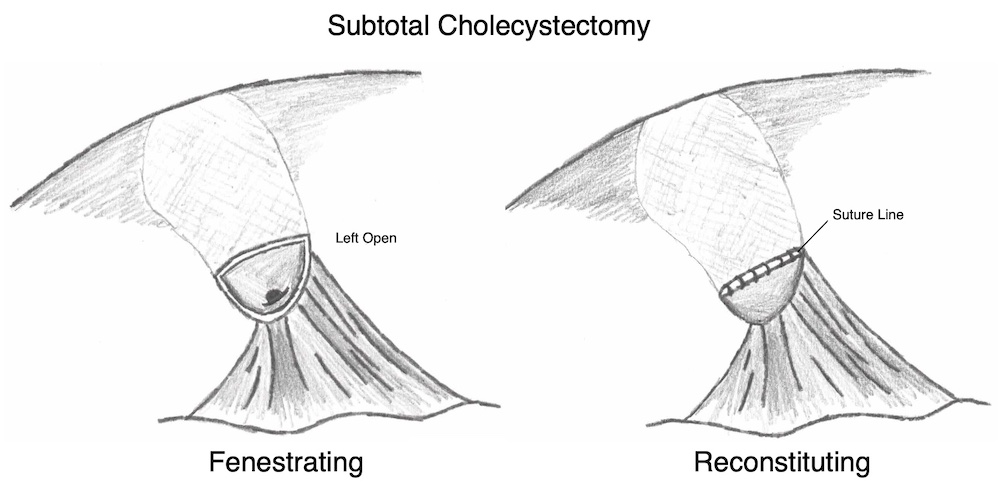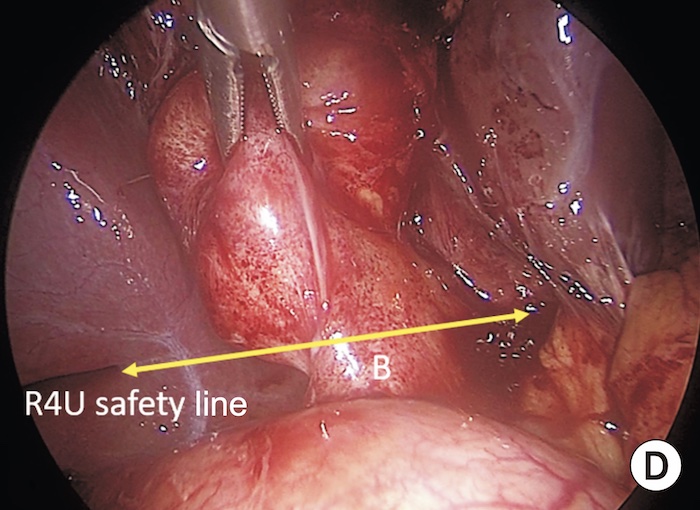Subtotal Cholecystectomy
Subtotal Cholecystectomy
David Ray Velez, MD
Table of Contents
Definitions
Definitions
- Subtotal Cholecystectomy: Removal of Almost All of the Gallbladder
- Partial Cholecystectomy: Removal of Only Part of the Gallbladder
- Quantitively Less Than a Subtotal Cholecystectomy Although Often Used Interchangeably
- Fundectomy: Removal of Only the Top-Half or Less of the Gallbladder
Types of Subtotal Cholecystectomy
- Subtotal Fenestrating Cholecystectomy: Leaves the Lumen Open and Does Not Produce a Remnant Gallbladder
- Generally the Preferred Technique in These Situations
- Subtotal Reconstituting Cholecystectomy: Closes the Lumen to Produce a Small Remnant Gallbladder
Outcomes
- Subtotal Fenestrating Cholecystectomy
- Higher Risk of Bile Leak (14.1% vs 7.9%) – 20% Resole Spontaneously and 75% Resolve with ERCP
- Subtotal Reconstituting Cholecystectomy
- Higher Risk for Recurrent Stones or Remnant Cholecystitis (11.6% vs 3.1%)
- No Difference in Bile Duct Injury, Infection, Re-Operation, or Need for Completion Cholecystectomy

Fenestrating Technique
Generally Start by Attempting a Routine Cholecystectomy and Then Transition to a Subtotal Cholecystectomy as a “Bail Out” Once Approaching a Zone of Significant Risk
Open and Drain the Gallbladder
- Gallbladder is Opened and Drained at the Fundus
- *Gallbladder May Already Be Perforated and Inadvertently Opened During a Difficult Dissection
- Bile, Stones, and Debris are Suctioned or Removed
Safety Landmarks
- The Cystic Duct/Artery are Not Dissected
- “Line of Safety” – An Imaginary Line Extending from Rouviere’s Sulcus to the Base of Segment 4b
- All Dissection Should Remain Superior to This “Line of Safety”
- “Shield of McElmoyle” – Refers to the Peritoneum Overlying the Cystohepatic Triangle
- The Bottom Lip of the Free Peritonealized Gallbladder is Left Behind to Protect from Entering the Hepatocytic Triangle
Remove the Gallbladder*
- The Gallbladder Incision is Extended Posteriorly Around the Gallbladder Neck
- The Anterior Wall of The Gallbladder is Completely Removed
- The Posterior Wall is Generally Left on the Cystic Plate Although the Superior-Most Portion May Be Excised
- Remnant Mucosa is Ablated by Cautery or Argon Beam
Completion
- May Consider Purse-String Closure of the Cystic Duct from the Inside if Feasible – Often Foregone Due to Safety Concerns
- Leave a Drain Near the Stump to Drain the Presumed Bile Leak (3x Risk)
- Close the Port Sites or Laparotomy Incision

Fenestrating Subtotal Cholecystectomy

Line of Safety Above a Retracted CBD (B) 1
Reconstituting Technique
Generally Start by Attempting a Routine Cholecystectomy and Then Transition to a Subtotal Cholecystectomy as a “Bail Out” Once Approaching a Zone of Significant Risk
The Procedure is Similar to a Fenestrating Technique
Instead of Leaving Open, The Lumen is Closed with Sutures or Staplers

Reconstituting Subtotal Cholecystectomy
References
- Gupta V. How to achieve the critical view of safety for safe laparoscopic cholecystectomy: Technical aspects. Ann Hepatobiliary Pancreat Surg. 2023 May 31;27(2):201-210. (Liscence: CC BY-NC-4.0)